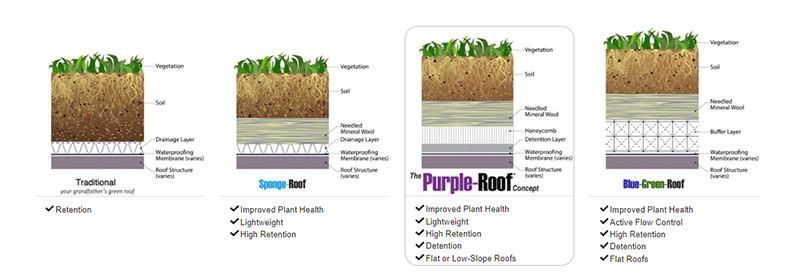Go straight to Purple-Roof Green Roof Modeler
Purple-Roof DETAILS
Essentially, stormwater detention is slowing water down so that the peak of the storm is reduced. This means that the intensity of the water rushing to the ground, or into the sewer systems is reduced, which allows for better soil percolation and significantly reduces the pressure on the sewer systems.
The damages caused by a storm are not so much volume-related as intensity-related. High-intensity storms can cause a lot of damage such as erosion and combined sewer overflows. Stormwater detention is there to reduce that intensity and prevent economic and ecological damages.
Available stormwater detention systems
There are many ways to achieve detention. A few examples are underground stormwater detention tanks, and cisterns, or over-ground detention basins or ponds, or detention green roofs. Some of these solutions provide immense stormwater storage, to then slowly release the water through drainage systems at a controlled and predictable rate.
Other systems, such as friction-based detention roofs (such as the Purple-Roof Concept) temporarily store water within a fabric and slowly release it over the cause of approximately 8-30 h. The benefit of using a detention roof system is that the rain is intercepted at the first possible point and thus is controlled downstream of that point.

We will discuss detention green roofs more in other articles and videos. Learn more about detention roofs: WHAT IS A DETENTION ROOF?
Read more about stormwater retention and detention in Living Architecture Monitor: Untangling Stormwater Retention and Detention by Brad Garner.

What is stormwater detention? Video transcript:
Hi, I’m Dick Bernauer, and I’m Joep van Vilsteren.
In the prior video we talked about retention, but let’s have a quick refresher.
Retention: water captured by the green roof that only leaves as vapor through evapotranspiration
Detention: water temporarily held by the green roof that flows out at a later time.
Dick: I’m going out on a limb here. This might be an unpopular opinion, but I think detention is more important than retention!
Joep: That’s a bold statement.
Difference between stormwater Retention and Detention
Dick: Let me explain.
As we showed in the last video, retention prevents some water from flowing to the drain.
And that’s great. Retention reduces runoff.
But when retention storage is full, it doesn’t do much. And retention, by definition, has a maximum capacity. So it must empty out and that takes time.
There is no way retention can solve ALL our stormwater problems. We simply cannot provide enough retention storage or ensure enough dry weather for retention to be reliable.
Joep: So, are you suggesting that we should not worry about retention?
Dick: We should absolutely use retention as a tool. But not our ONLY tool.
Water flowing is not so much of a problem. Water flowing RAPIDLY at HIGH VOLUMES is a problem. This is where detention can help.
Joep: I think we filmed Derek demonstrating this.
So here we have three streams. We let the same volume of water flow through each stream. But at a different velocity.
Joep: So, I’m assuming the faster-moving water will cause some damage. The urban stormwater discharge does cause major stream blowouts and erosion. And detention can help slow down and space out that water, so our scenarios look more like the first two examples.
But let’s look at one more example: what happens in pipes!
Those pipes have limitations just like streams have limits. But when a pipe is overwhelmed, it has two options: back up or overflow.
A lot of cities around the globe combine sanitary sewers and stormwater. That’s right, your poo gets mixed with stormwater in the same pipe. This seemed like a good idea 100 years ago, but now it is a major problem.
You do NOT want that water to back up into your home, so cities use the other option: release the sewage when the pipes are overwhelmed. This is called a combined sewer overflow, or CSO.
“Total volume of flow does not cause CSOs. High intensity of flow causes CSOs.”
I think Dick made a pretty compelling argument about how detention is such a reliable stormwater management strategy.
Retention is great for reducing volume and lowering AVERAGE runoff over a large area. Or retention can lower average runoff over the course of a year. So, retention helps at the city scale.
But civil engineers need stormwater management tools that work for an individual project every time. All the time. And detention does just that.
Dick: Detention practices are more reliable, mostly because they do not rely on the sun. Instead of capturing water and letting it evaporate, they capture water, slow it down, and then let it out slowly.
The best solution is a combination of retention and detention.
So this video showed streams and pipes, because that’s probably easiest to visualize. In our next video, we’ll look at ACTUAL green roofs.
Stormwater Detention Resources
If you are interested to learn more about stormwater detention, please check out these articles!
Using a Detention Roof to Create a Green Roof ROI
Does a Detention Roof Make Sense for Your Project?
What is the Difference Between Green Roof Retention and Detention?

